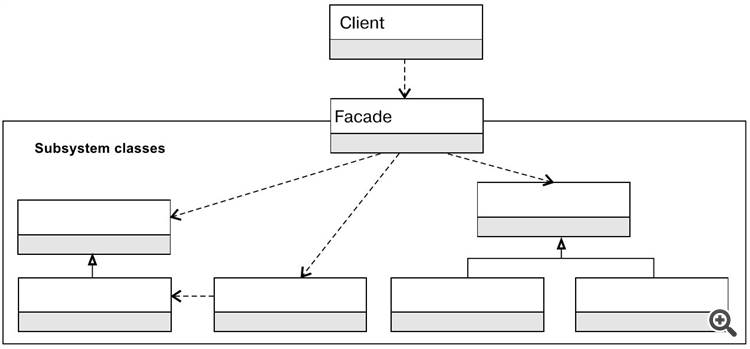/**************************************************************** Programming patterns - Facade Provide a unified interface to a set of interfaces in a subsystem. Facade defines a higher- level interface that makes the subsystem easier to use. /**/ 
/****************************************************************/ class SubSystemA {public:void OperationA() {Print("SubSystem A");}}; /**/ class SubSystemB {public:void OperationB() {Print("SubSystem B");}}; /**/ class SubSystemC {public:void OperationC() {Print("SubSystem C");}}; /****************************************************************/ class Facade { public: void OperationAB() {subSystemA.OperationA(); subSystemB.OperationB();} void OperationBC() {subSystemB.OperationB(); subSystemC.OperationC();} protected: SubSystemA subSystemA; SubSystemB subSystemB; SubSystemC subSystemC; };
/**************************************************************** Applicability Use the Facade pattern when *you want to provide a simple interface to a complex subsystem. Subsystems often get more complex as they evolve. Most patterns, when applied, result in more and smaller classes. This makes the subsystem more reusable and easier to customize, but it also becomes harder to use for clients that don't need to customize it. A facade can provide a simple default view of the subsystem that is good enough for most clients. Only clients needing more customizability will need to look beyond the facade. *there are many dependencies between clients and the implementation classes of an abstraction. Introduce a facade to decouple the subsystem from clients and other subsystems, thereby promoting subsystem independence and portability. *you want to layer your subsystems. Use a facade to define an entry point to each subsystem level. If subsystems are dependent, then you can simplify the dependencies between them by making them communicate with each other solely through their facades. Participants *Facade *knows which subsystem classes are responsible for a request. *delegates client requests to appropriate subsystem objects. *subsystem classes *implement subsystem functionality. *handle work assigned by the Facade object. *have no knowledge of the facade; that is, they keep no references to it. Collaborations *Clients communicate with the subsystem by sending requests to Facade, which forwards them to the appropriate subsystem object(s). Although the subsystem objects perform the actual work, the facade may have to do work of its own to translate its interface to subsystem interfaces. *Clients that use the facade don't have to access its subsystem objects directly. Consequences The Facade pattern offers the following benefits: 1. It shields clients from subsystem components, thereby reducing the number of objects that clients deal with and making the subsystem easier to use. 2. It promotes weak coupling between the subsystem and its clients. Often the components in a subsystem are strongly coupled. Weak coupling lets you vary the components of the subsystem without affecting its clients. Facades help layer a system and the dependencies between objects. They can eliminate complex or circular dependencies. This can be an important consequence when the client and the subsystem are implemented independently. Reducing compilation dependencies is vital in large software systems. You want to save time by minimizing recompilation when subsystem classes change. Reducing compilation dependencies with facades can limit the recompilation needed for a small change in an important subsystem. A facade can also simplify porting systems to other platforms, because it's less likely that building one subsystem requires building all others. 3. It doesn't prevent applications from using subsystem classes if they need to. Thus you can choose between ease of use and generality. Related Patterns *Abstract Factory can be used with Facade to provide an interface for creating subsystem objects in a subsystem-independent way. Abstract Factory can also be used as an alternative to Facade to hide platform-specific classes. *Mediator is similar to Facade in that it abstracts functionality of existing classes. However, Mediator's purpose is to abstract arbitrary communication between colleague objects, often centralizing functionality that doesn't belong in any one of them. A mediator's colleagues are aware of and communicate with the mediator instead of communicating with each other directly. In contrast, a facade merely abstracts the interface to subsystem objects to make them easier to use; it doesn't define new functionality, and subsystem classes don't know about it. Usually only one Facade object is required. Thus Facade objects are often Singletons /**/ /**************************************************************** Example of the Facade pattern usage. Client. /****************************************************************/ void OnStart() { Facade facade; facade.OperationAB(); {string s; for(int i=0; i<11; i++) {s+="-";} Print(s);} facade.OperationBC(); } /**************************************************************** Output: SubSystem A SubSystem B ----------- SubSystem B SubSystem C /**/















